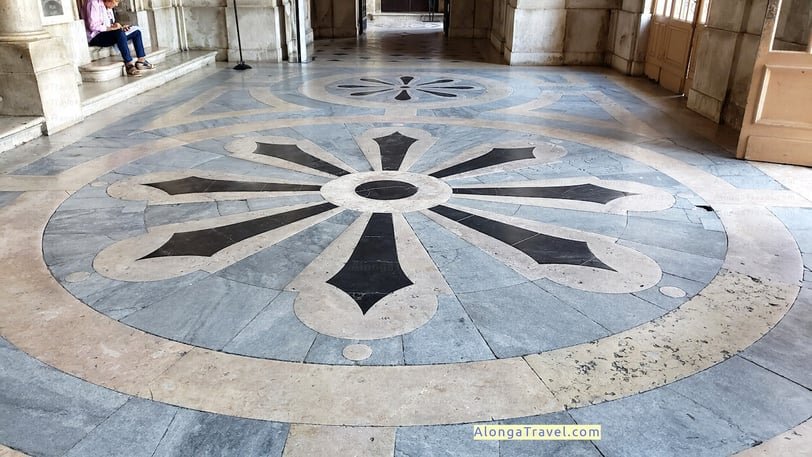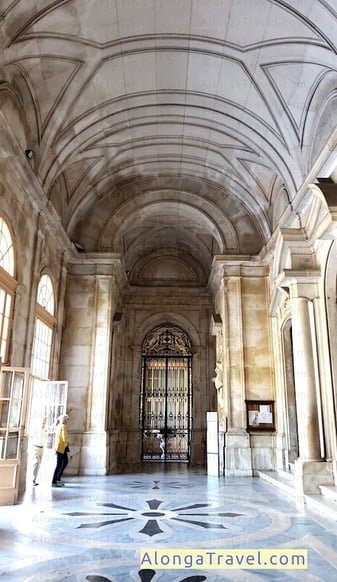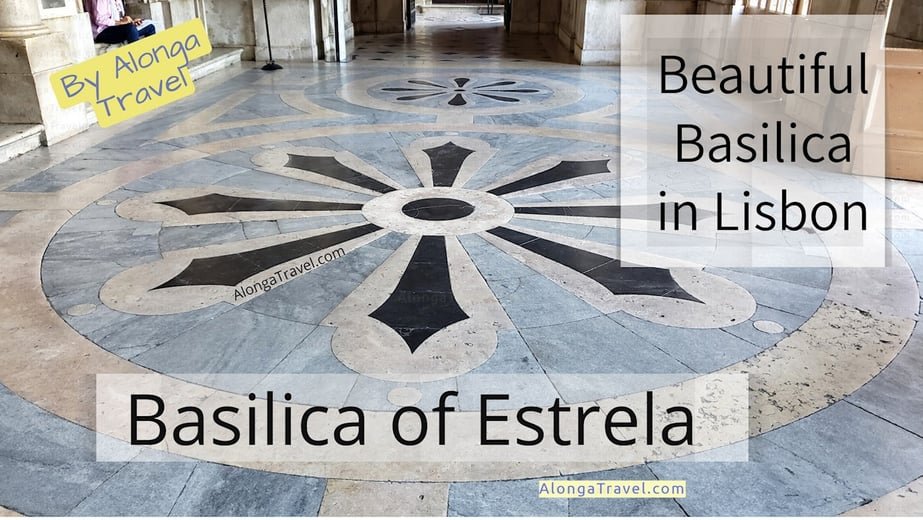Beautiful Estrela Basilica, also known as the Basilica of the Star, has some intriguing facts about its creation. Located in the civil parish of Estrela, in Lisbon, Portugal, it is a magnificent example of late Baroque architecture and is considered one of the most iconic and emblematic buildings in the city.

I discovered this Basilica while deciding to ride tram 28 over its entire route in Lisbon. However, when I saw this beautiful church, I just had to get out and explore it and resume my tram ride later.
Basilica of Estrela: Intriguing Architectural Gem in Lisbon
When I saw this basilica while on a tram ride, and I knew I had to get out to explore, though this picture doesn’t do the sight I saw justice.
Interesting facts about Basilica da Estrela in Lisbon
Here are some interesting facts about the Basilica da Estrela in Lisbon:
Sacred Heart of Jesus
The Estrela Basilica was the first church in the world dedicated to the Sacred Heart of Jesus, that’s why it is also called Basilica of the Sacred Heart of Jesus. In 1781 the convent was established for the Carmelite Order.
Freemasonry Myths
There are persistent myths and theories suggesting that the Basilica of Estrela contains symbols and references related to Freemasonry, although these claims remain controversial and unproven. What is proven, though, the church’s connection to astronomy.
And Freemasonry has intriguing, albeit somewhat elusive connection to astrology as well.
Masonic symbols often include the sun, moon, and stars. The sun, represented by the circumpunct (a circle with a dot), signifies the point where the brotherhood stands. It symbolizes vitality and the spiritual will of humanity. Masonic artists and architects also favor representations of zodiacs and star charts. Yet, this doesn’t mean that astrology directly influenced Masonic teachings or rituals, or the Estrela’s church connection to freemasonry.
Astronomical Connections
Here is a very indulging fact – Basilica de Estrela was designed to align with the rising sun on its dedication day. The central nave of the Estrela church (the main, elongated space that runs from the entrance to the altar) aligns with the rising sun on the day of the church’s dedication, August 31st. This was influenced by astronomical calculations.
While it is unusual for a Catholic church to have connections to pagan practices like astrology, throughout history, some churches have included astrological symbols in their architecture and artwork.
This happened because some Christian leaders incorporated existing astrological features from before Christianity into church structures. Solstices, equinoxes, zodiac signs and celestial motifs like planets, and constellations can be found in churches, serving both religious and practical purposes.
Magnificent marble
When you enter, right away you see amazing multi-colored marble stars on the floor of this Basilica of the Star. It’s because the basilica’s inside is decorated with beautiful marble sourced from different parts of Portugal.
You can see the pink marble from Arrábida, the gray marble from Pêro Pinheiro, and the yellow marble from Sintra in Estrela Basilica. The marble floor is simply spectacular, but you can also see marble used in many other parts of the church!
Carillon Bells
Estrela Basilica’s bell tower houses a carillon of 54 bells, which are played manually using a keyboard. The largest bell weighs over 4 tons, and the carillon is one of the largest in Portugal.
Earthquake Resistance
During the construction of the basilica of Estrela, specific measures were taken to ensure its resistance against earthquakes, which were a common occurrence in Lisbon. This included the use of a unique construction technique involving timber frames and metal rods – the Pombaline cage. Read my post about it and other facts about Pombaline architecture in Lisbon in details in my other post.
Underground Cistern
Beneath the basilica lies a vast underground cistern, which was used to collect and store water for the church and the surrounding neighborhood.
Nativity Scene
The Basilica of Estrela is famous for its intricate and impressive terracotta Nativity scene, which is displayed during the Christmas season. This tradition dates back to the 18th century.
It was sculptured in 1783 by Joaquim Machado de Castro, and features thousands of figurines in elaborate scenes.
So, these are some of the interesting facts. Now, let’s learn about the church’s history and architecture in more details.

History of Estrela Basilica
The construction of the Basilica da Estrela began in 1779 and was commissioned by Queen Maria I as a gesture of gratitude for the birth of her son and heir, José, Prince of Brazil. The church was built on the site of a former convent and was designed by the Italian architect Giacomo Azzolini. The construction process was lengthy, spanning over several decades, and was not completed until 1789.
Architecture of Basilica of Estrela
While the overall architectural style is Baroque, with a grandiose and ornate façade adorned with intricate carvings and sculptures, the Basilica da Estrela incorporates elements from different styles, including Neoclassical and Rococo.
This fusion of styles creates a unique and eclectic aesthetic.
“Over the four main columns of the façade are four monumental statues depicting Faith, Devotion, Gratitude, and Liberality. Within four niches are St. Theresa of Avila, St. Mary Magdalene de Passi, St. Elijah, and St. John of the Cross”, this is how the Baroque art museum database describes it.

Basilica Interior
The church’s inside is also beautiful.
Incredible marble floor
There first thing when you enter through the outside door, you see a very beautiful floor in the narthex in Estrella Basilica. This marble multi-colored star is very impressive!
Btw, would you like to know the difference between a foyer and a narthex?
A foyer is a designated entry area in a home or office, while a narthex serves as an entry gathering space in a religious setting. Churches typically have a narthex, whereas offices typically have a foyer.
Beautiful dome
One of the most impressive things about the Basilica da Estrela is its incredible dome. It reaches over 197 feet (60 meters) high. This beautiful grey and pink dome is decorated with detailed carvings and sculptures, and inside, there are stunning frescoes and stained-glass windows that fill the space with a warm, heavenly light.
It has a huge middle section with a tall, arched ceiling that is beautifully decorated with intricate stucco work and frescoes. The altars and chapels in the church are adorned with lovely marble, ornate carvings in gold, and religious artworks, giving a feeling of richness and splendor.



Tomb of Queen Maria I
The Neo-Classical tomb of Queen Maria I inside the Basilica of Estrela was created in the first half of the 19th century by Faustino José Rodrigues and Giovanni Chiari. It is made of white, black, and pink marble and includes two urns and an inscription honoring the queen. The sarcophagus is held up by two lions.
Sacred Heart Chapel
One of the most notable chapels within the basilica is the Sacred Heart Chapel, which features an impressive altar, decorated with multi-colored marble, intricate carvings and gilded decorations.
You can find more historical facts in a book Memoirs of the Estrêla basilica: written in 1790 / Manuel Pereira Cidade from Biblioteca Nacional de Portugal.
Modern Days of Basilica of Estrela
Today, the Basilica da Estrela is still used as a church for worship and is a well-liked tourist spot in Lisbon. People can enjoy the church’s beautiful architecture, join in mass or other religious events, or just relax and take in the peaceful vibe of this stunning building.
The Basilica da Estrela is also a popular venue for cultural events, concerts, and exhibitions. It’s an important cultural and artistic hub in the city.

You can see the Tomb of Queen Maria I on the left side.
Afterward you can go to the lovely park across the street – Estrela Park, with overgrown palm trees, a pond, a café, and lots of benches to relax. Or, you can jump into tram 28 and tram 25 (both stop in front of Basilica de Estrela) and continue your exploration of Lisbon.
The surrounding square, known as the Praça da Estrela, is a popular gathering place for locals and visitors alike.

Tram 28 stopped in front of Estrela park on one side and Basilica of Estrela on the other side.
Estrela Basilica (Lisboa) mass times
- Weekday: 8.00am, 12.00pm, 7.00pm
- Saturday: 12.00pm
- Sunday: 7.00pm (vigil), 10.00am, 12.00pm, 7.00pm
Basilica’s address:
Praça da Estrela, Lisboa, 1200-1350
Tel: 213 960 915
The Basilica of Estrela is a beautiful example of Baroque architecture, intriguing past and reflects Lisbon’s artistic and religious history. Don’t miss this beauty when exploring the city’s cultural and architectural gems.
BTW, do you want to know difference between cathedral and basilica?
Difference between cathedral and basilica
Cathedral:
– A cathedral is the principal church building of a diocese and serves as the seat of the bishop.
– It represents the spiritual center of a specific region and holds significant religious authority.
– However, the status of a cathedral is not permanent and can change over time.
A cathedral is the main church for a bishop or high-ranking religious leader. There is usually only one cathedral per denomination per city. It is associated with the administration of an area. People often use the term cathedral for large churches, but this is not technically correct.
Basilica:
– A basilica is the highest permanent designation for a church building.
– Originally, basilicas were Roman public buildings with specific architectural features.
– In Catholicism, the pope designates certain churches as basilicas for various reasons.
– Major basilicas, like St. Peter’s Basilica in Vatican City (Rome), hold special precedence and importance.
Originally, a basilica was a Roman building used for business and trading. It had specific architectural features that supported its use as a public, open facility for business, trading, etc. These typically—but not always—included colonnades, naves, and aisles, not unlike a modern pedestrian mall.
In early Christianity, churches with similar features were called basilicas.
In Catholicism, the pope designates some churches as basilicas for different reasons, making them important sites.
Related: Influence of Christian theology and theologians on architecture.
More complicated details of this comparison, if you’re up to this:
- Papal or major basilicas are the most important churches.
- In some rankings, a bishop’s cathedral is more important than other churches in the same diocese, even if they are minor basilicas.
- If the cathedral belongs to a smaller diocese, it defers to the metropolitan’s cathedral. A primate’s cathedral is seen as more important than other metropolitan cathedrals in the area. Collegiate churches are another type, which might also be minor basilicas.
In summary, while cathedrals are associated with bishops and dioceses, basilicas represent a distinct and prestigious category of Christian buildings.
Let’s connect on social media!
Found this post helpful? Please, consider supporting my work and the website maintenance cost, thank you!
Subscribe to my periodic newsletter for my new posts. New here? Visit my main Alonga Travel page.

